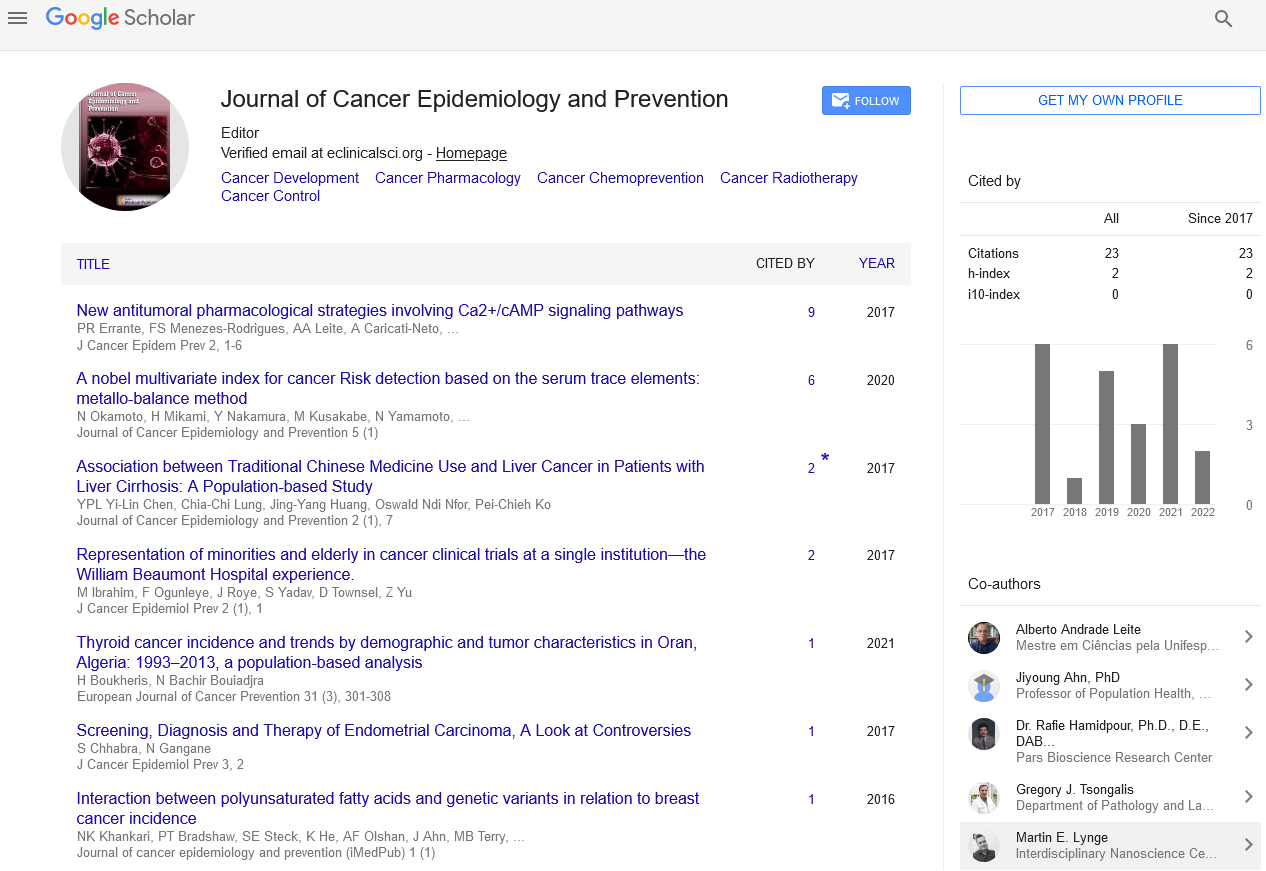Abidugun Azi*
Department of Medical Science, Elizade University, Ondo, Nigeria
- *Corresponding Author:
- Abidugun Azi
Department of Medical Science
Elizade University
Ondo, Nigeria
E-mail: aziabi@gun.in.com
Received Date: November 08, 2021; Accepted Date: November 22, 2021; Published Date: November 29, 2021
Citation: Azi A (2021) A Brief note on Lung Cancer. J Cancer Epidemiol Prev Vol.6 No.5:e004
Description
Lung cancer, also known as lung melanoma, since about 98-99
of all lung cancers are lymphomas, is a tissue lung tumor
characterized by unbridled cell growth in tissues of the lung.
Lung lymphomas, tissue cells that appear as epithelial cells or
from tissues composed of epithelial cells. Other lung cancers,
similar as the rare sarcomas of the lung, are generated by the
tissue metamorphosis that connective tissues (i.e. whim-whams,
fat, muscle, bone), which arise from mesenchyme cells.
Lymphomas and tubercles (from lymphoid and melanocyte cell
lineages) can also infrequently affect in lung cancer. In time, this
unbridled growth can spread beyond the lung-either by direct
extension, by entering the lymphatic rotation, the
haematogenous, and blood borne spread the process called
metastasis other, numerous with the tobacco of the body.
Utmost cancers that start in the lung, known as primary lung
cancers, are lymphomas. The two main types are Small Cell
Lung Melanoma (SCLM) and Non Small Cell Lung Melanoma
(NSCLM). The most common symptoms are coughing including
coughing up blood, weight loss, briefness of breath, and casket
pains.
Numerous of the symptoms of lung cancer such as poor
appetite, weight loss, fever, fatigue aren't specific. In numerous
people, the cancer has formerly spread beyond the original
point by the time they've symptoms and seek medical attention.
Symptoms that suggest the presence of metastatic include
weight loss, bone pain, and neurological symptoms include
headaches, conking, storms, or branch weakness. Common
spots of spread include the brain, bone, adrenal glands, contrary
lung, liver, and pericardium. About 10 of people with lung
cancer don't have symptoms at opinion; these cancers are
apropos plant on routine casket radiography. Depending on the
type of tumor, Para neoplastic phenomenon symptoms not due
to the original presence of cancer may originally attract
attention to the complaint. In lung cancer, these phenomenon may include
hyperkalemia, pattern of antidiuretic hormone (abnormally
concentrated urine and adulterated blood), ectopic ACTH
product, or Lambert Eaton Myasthenia Pattern (LEMP). Tumors
in the top of the lung, may attack the original part of the
sympathetic nervous system, performing in Horner's pattern
(dropping of the eyelid and a small pupil on that side), as well as
damage to the brachial super system. Tobacco smoking is by far
the main contributor to lung cancer. Cigarette contains at least
73 known carcinogens, NNK, butadiene, and a radioactive
isotope of polonium polonium-210. Across the advanced world,
90 of lung cancer deaths in men and 70 of those in women
during 2000 were attributed to smoking. Smoking accounts for
about 85 of lung cancer cases. Vamping may be a threat factor
for lung cancer, but lower than that of cigarettes, and farther
exploration is necessary due to the length of time it can take for
lung cancer to develop following an exposure to carcinogens.
Passive smoking the inhalation of group from another's smoking
is a cause of lung cancer in non -smokers. A unresisting smoker
can be defined as someone either living or working with a
smoker. Studies from the US, the UK and other European
countries have constantly shown a significantly increased threat
among those exposed to unresisting smoking. The threat of
developing lung cancer increases by 25-28. Examinations of side
sluice group suggest that it's more dangerous than direct
mainstream group. Marijuana group contains numerous of the
same carcinogens as that plant, but the effect of smoking
cannabis on lung cancer threat isn't clear. A 2013 review didn't
find an increased threat from light to moderate use. A 2014
review plant that smoking cannabis doubled the threat of lung
cancer, though cannabis is in numerous countries generally
mixed with tobacco.

